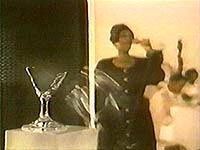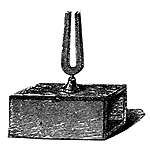Hand-Crank Generator DIY STEM Kit
$9.99$5.95
 While breaking glass with sound is an interesting trick, it really takes a lot of effort to get the job done. First off, the glass in question needs to be crystal, not just any glass. Crystal, resonates all at one particular harmonic frequency. Try getting a crystal wineglass, dipping your finger in water, and rubbing it gently around the rim of the glass. Your finger will vibrate on the glass, and once you get it right and consistent, the glass will 'hum'.
While breaking glass with sound is an interesting trick, it really takes a lot of effort to get the job done. First off, the glass in question needs to be crystal, not just any glass. Crystal, resonates all at one particular harmonic frequency. Try getting a crystal wineglass, dipping your finger in water, and rubbing it gently around the rim of the glass. Your finger will vibrate on the glass, and once you get it right and consistent, the glass will 'hum'.
 Waves of any sort set up sympathetic vibrations in the materials they impinge upon, which is the principle behind many many things, including telephones and radar. The glass hums (and doesn't shatter) because the amplitude of the waves (the actual physical displacement that creates the sound) is not sufficient to surpass the strength of the glass. If you generate a sound that is the same frequency the glass resonates at, after you turn off the sound, the glass will hum a little, much like a pitchfork. To break the glass, you need to broadcast not only a sound that is *just* the right frequency, but also has a high enough amplitude (loudness) to exceed the strength of the glass to resist those vibrations. When the sound gets too loud for the glass to vibrate, it shatters the glass. I HIGHLY recommend asking a teacher about this, since doing experiments with crystalware at home is not likely to win much support whoever owns the crystal.
Waves of any sort set up sympathetic vibrations in the materials they impinge upon, which is the principle behind many many things, including telephones and radar. The glass hums (and doesn't shatter) because the amplitude of the waves (the actual physical displacement that creates the sound) is not sufficient to surpass the strength of the glass. If you generate a sound that is the same frequency the glass resonates at, after you turn off the sound, the glass will hum a little, much like a pitchfork. To break the glass, you need to broadcast not only a sound that is *just* the right frequency, but also has a high enough amplitude (loudness) to exceed the strength of the glass to resist those vibrations. When the sound gets too loud for the glass to vibrate, it shatters the glass. I HIGHLY recommend asking a teacher about this, since doing experiments with crystalware at home is not likely to win much support whoever owns the crystal.